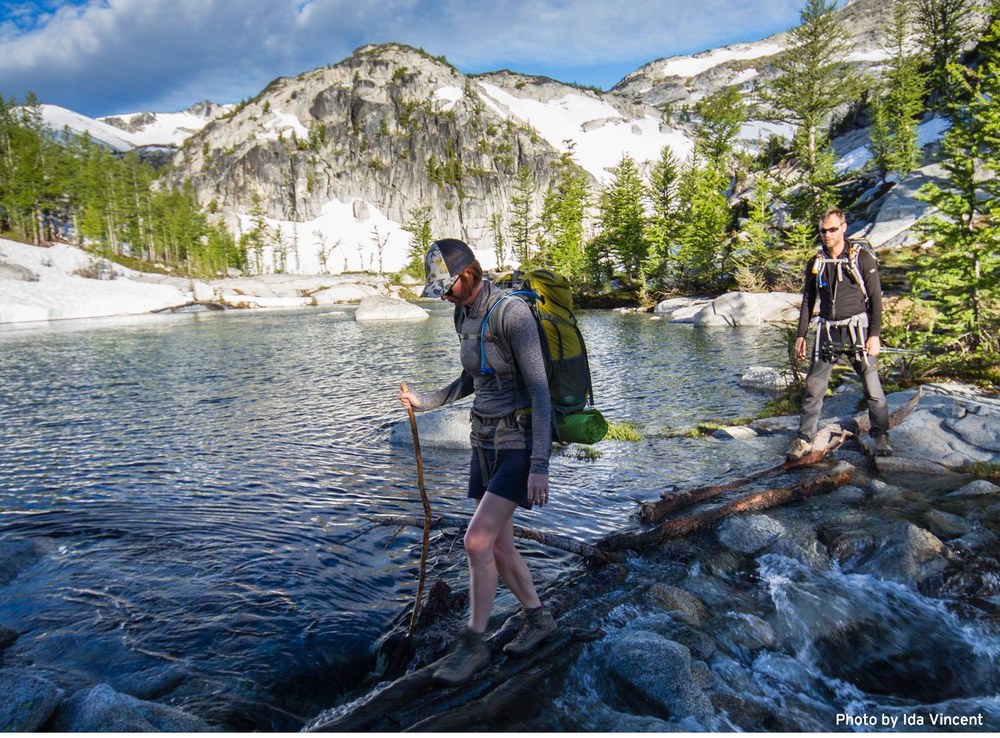
by Courtenay W. Schulman, MS. CSCS
One of the most common questions I hear Mountaineers ask is how to prevent knee pain on steep hikes. Herein are strategies and resources for increasing your stamina, strength and flexibility so that knee pain may become a distant memory.
Cardiovascular Training
Cardiovascular machines at the gym are excellent at training the uphill propulsion muscles in the hips, particularly the glutes. However, it is more challenging to find machines to train the inner teardrop-shaped quadriceps muscle, the VMO (Vastus Medialis Obliquus), targeted in downward walking. One solution: Try walking backwards on a moderately inclined treadmill.
If you train on stairs in your apartment or office building, include walking down the stairs. While climbing down may not sustain an elevated heart rate, it WILL help strengthen the quads for downhill hiking. If walking down stairs bothers your knees, start with a few flights each workout and gradually add more as your endurance improves. You also may want to include the 'Reverse Step-up' in your strength routine.
Reverse Step-up exercise
Stand on top of a step or box (start with 4-6 inches and work up to 10-12 inches.) Step off the front as though you're going down a set of stairs, allowing the trailing heel to raise up and lead foot to land firmly on the floor in front. Reverse your position (without rebounding off your lead foot) allowing the trail leg (the one still on the step) to lift you back up to the top (essentially walking backwards up a step), and balance without letting your lead leg touching the step. Work your weaker knee first before completing the same number of repetitions on the other leg.
Gradual Overload
As with any sort of training, you need to overload the body gradually. The biggest mistake you can make is carrying the same weight you used last fall on your very first hike of the season. If you haven't been carrying a pack, start with a light load, perhaps only 10-15 pounds.
Each week, add no more than 10%. If you start with a ten-pound pack, add a pound per week. If you can hike five miles without pain, add half a mile the next trip. Anything more may cause inflammation of the tendons and ligaments in your legs, resulting in knee pain.
Pole Considerations
Trekking poles can help take some of the stress off the knees, particularly on steep terrain that might be icy or muddy. However, if you plan to do climbs with an ice axe in summer, you will want to develop solid balance and confidence in traveling with one hand on an ice axe on your climbs. If you hike or backpack, you can use poles year-round. Just be aware that in the unlikely event that you forget — or, heaven forbid, break or lose — your poles, occasionally training without poles can prepare you mentally and physically for increased balance so that you can prevent falling.
Courtenay Schurman is an NSCA-CSCS certified personal trainer, Precision Nutrition Level 1 Certified nutrition coach, and co-owner of Body Results. She specializes in training outdoor athletes. For more how-to exercises and tips, visit her website at www.bodyresults.com or send a question to court@bodyresults.com.
Add a comment
Log in to add comments.Counting down to my appointment with an orthopedic surgeon on Aug. 1st and getting scheduled for knee replacement. My goal is to have both done so I can finally go out and enjoy the trails I haven't been able to hike because of severe knee painosteoarthritis. My knees are damaged due to sports injuries, with wear and tear over the years making them worse. I've had to live with this knee pain for over 20 years, so it will be a relief to finally get them done!
The VA wouldn't replace them until after I turned 55, so replacing them earlier wasn't an option. Heck, the military wouldn't even repair my torn ACL while I was active duty!
Wishing you the best of luck Anita!
PS - We miss you and Doug at the Photography potlucks!
 Courtenay Schurman
Courtenay Schurman